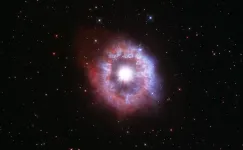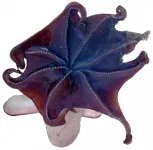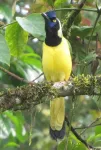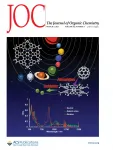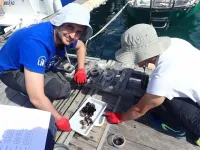(Press-News.org) In celebration of the 31st anniversary of the launching of NASA's Hubble Space Telescope, astronomers aimed the renowned observatory at a brilliant "celebrity star," one of the brightest stars seen in our galaxy, surrounded by a glowing halo of gas and dust.
The price for the monster star's opulence is "living on the edge." The star, called AG Carinae, is waging a tug-of-war between gravity and radiation to avoid self-destruction.
The expanding shell of gas and dust that surrounds the star is about five light-years wide, which equals the distance from here to the nearest star beyond the Sun, Proxima Centauri.
The huge structure was created from one or more giant eruptions about 10,000 years ago. The star's outer layers were blown into space - like a boiling teapot popping off its lid. The expelled material amounts to roughly 10 times our Sun's mass.
These outbursts are the typical life of a rare breed of star called a luminous blue variable, a brief convulsive phase in the short life of an ultra-bright, glamorous star that lives fast and dies young. These stars are among the most massive and brightest stars known. They live for only a few million years, compared to the roughly 10-billion-year lifetime of our Sun. AG Carinae is a few million years old and resides 20,000 light-years away inside our Milky Way galaxy.
Luminous blue variables exhibit a dual personality: They appear to spend years in quiescent bliss and then they erupt in a petulant outburst. These behemoths are stars in the extreme, far different from normal stars like our Sun. In fact, AG Carinae is estimated to be up to 70 times more massive than our Sun and shines with the blinding brilliance of one million suns.
"I like studying these kinds of stars because I am fascinated by their instability. They are doing something weird," said Kerstin Weis, a luminous blue variable expert at Ruhr University in Bochum, Germany.
Major outbursts such as the one that produced the nebula occur once or twice during a luminous blue variable's lifetime. A luminous blue variable star only casts off material when it is in danger of self-destruction as a supernova. Because of their massive forms and super-hot temperatures, luminous blue variable stars like AG Carinae are in a constant battle to maintain stability.
It's an arm-wrestling contest between radiation pressure from within the star pushing outward and gravity pressing inward. This cosmic match results in the star expanding and contracting. The outward pressure occasionally wins the battle, and the star expands to such an immense size that it blows off its outer layers, like a volcano erupting. But this outburst only happens when the star is on the verge of coming apart. After the star ejects the material, it contracts to its normal size, settles back down, and becomes quiescent for a while.
Like many other luminous blue variables, AG Carinae remains unstable. It has experienced lesser outbursts that have not been as powerful as the one that created the present nebula.
Although AG Carinae is quiescent now, as a super-hot star it continues pouring out searing radiation and powerful stellar wind (streams of charged particles). This outflow continues shaping the ancient nebula, sculpting intricate structures as outflowing gas slams into the slower-moving outer nebula. The wind is traveling at up to 670,000 miles per hour (one million km/hr), about 10 times faster than the expanding nebula. Over time, the hot wind catches up with the cooler expelled material, plows into it, and pushes it farther away from the star. This "snowplow" effect has cleared a cavity around the star.
The red material is glowing hydrogen gas laced with nitrogen gas. The diffuse red material at upper left pinpoints where the wind has broken through a tenuous region of material and swept it into space.
The most prominent features, highlighted in blue, are filamentary structures shaped like tadpoles and lopsided bubbles. These structures are dust clumps illuminated by the star's reflected light. The tadpole-shaped features, most prominent at left and bottom, are denser dust clumps that have been sculpted by the stellar wind. Hubble's sharp vision reveals these delicate-looking structures in great detail.
The image was taken in visible and ultraviolet light. Ultraviolet light offers a slightly clearer view of the filamentary dust structures that extend all the way down toward the star. Hubble is ideally suited for ultraviolet-light observations because this wavelength range can only be viewed from space.
Massive stars, like AG Carinae, are important to astronomers because of their far-reaching effects on their environment. The largest program in Hubble's history - the Ultraviolet Legacy Library of Young Stars as Essential Standards - is studying the ultraviolet light of young stars and the way they shape their surroundings.
Luminous blue variable stars are rare: Less than 50 are known among the galaxies in our local group of neighboring galaxies. These stars spend tens of thousands of years in this phase, a blink of an eye in cosmic time. Many are expected to end their lives in titanic supernova blasts, which enrich the universe with heavier elements beyond iron.
INFORMATION:
Hubble Trivia
Launched on April 24, 1990, NASA's Hubble Space Telescope has made more than 1.5 million observations of about 48,000 celestial objects.
In its 31-year lifetime, the telescope has racked up more than 181,000 orbits around our planet, totaling over 4.5 billion miles.
Hubble observations have produced more than 169 terabytes of data, which are available for present and future generations of researchers.
Astronomers using Hubble data have published more than 18,000 scientific papers, with more than 900 of those papers published in 2020.
The Hubble Space Telescope is a project of international cooperation between NASA and ESA (European Space Agency). NASA's Goddard Space Flight Center in Greenbelt, Maryland, manages the telescope. The Space Telescope Science Institute (STScI) in Baltimore, Maryland, conducts Hubble science operations. STScI is operated for NASA by the Association of Universities for Research in Astronomy in Washington, D.C.
Media Contacts:
Claire Andreoli
NASA's Goddard Space Flight Center, Greenbelt, Md.
claire.andreoli@nasa.gov
Donna Weaver
Space Telescope Science Institute, Baltimore, Maryland
Ray Villard
Space Telescope Science Institute, Baltimore, Maryland
PUBLICATION PARTNERS: NASA, ESA, STScI
Now that teens and young adults across the country account for an increasing share of COVID-19 cases, and many have become eligible for vaccination, several recently published studies based on polls of this age group provide insights into the kinds of messaging that might work best for both preventing transmission and vaccine uptake.
Using data from text-message polls of people between the ages of 14 and 24 taken at several points in 2020, researchers from the University of Michigan find a clear theme: that most young people are taking COVID-19 seriously and trying to follow public health guidance, and that many of them they are motivated by the desire to protect ...
ABERDEEN PROVING GROUND, Md. -- Army and Arizona State University researchers identified a set of approaches to help scientists assess how well autonomous systems and humans communicate.
These approaches build on transformational scientific research efforts led by the Army's Robotics Collaborative Technology Alliance, which evolved the state of robots from tools to teammates and laid the foundation for much of the service's existing research into how humans and robots can work together effectively.
As ideas for autonomous systems evolve, and the possibilities ...
Researchers from the Faraday Institution's SOLBAT project have made a significant step in understanding how and why solid-state batteries (SSBs) fail. A paper, published in Nature Materials on 22 April, provides answers to one important piece of the scientific puzzle.
To make step changes in electric vehicle (EV) battery range and safety at a lower cost, new battery chemistries that are "beyond lithium ion" must be developed. SSBs are one such promising technology, but mass market adoption has been held back by several key technical challenges that cause the battery to fail when charged and discharged.
SSBs can short circuit after repeating charging and discharging. One well-recognised cause of battery failure is the growth of dendrites, branching networks of lithium that ...
An evolutionary biologist from the University of Bonn brought a new octopus species to light from depths of more than 4,000 meters in the North Pacific Ocean. The sensational discovery made waves in the media a few years ago. Researchers in Bonn have now published the species description and named the animal "Emperor dumbo" (Grimpoteuthis imperator). Just as unusual as the organism is the researchers' approach: in order to describe the new species, they did not dissect the rare creature, but instead used non-destructive imaging techniques. The results have now been published in the prestigious journal BMC Biology.
In the summer of 2016, Dr. Alexander ...
A continental-scale network of conservation sites is likely to remain effective under future climate change scenarios, despite a predicted shift in key species distributions.
New research, led by Durham University and published in the journal Frontiers in Ecology and Evolution, investigates the impacts of potential climate change scenarios on the network of Important Bird and Biodiversity Areas (IBAs) across the Caribbean, and Central and South America.
The research was carried out in collaboration with Senckenberg Biodiversity and Climate Research Centre, BirdLife International and the National Audubon Society.
IBAs are sites identified as being internationally important for the conservation of bird populations, with over 13,000 ...
There are many different types of cancer, but they all have one thing in common: errors in the signals that control normal cell behaviour can cause uncontrolled cell growth and cell division, leading to a tumour. An enzyme called SHP2 plays a key role in this regard. SHP2 is a signalling molecule that in its activated state stimulates cell proliferation. In a normal healthy body, the rates of cell proliferation and cell death are balanced and tumours do not develop. However, if SHP2 becomes too active, the number of cells being created outweighs the number that die, which can lead to the formation of dangerous tumours. Enhanced SHP2 activity resulting from genetic ...
Researchers at the University of Cincinnati say a regulatory protein found in skeletal muscle fiber may play an important role in the body's fight or flight response when encountering stressful situations.
The protein, fast skeletal myosin binding protein-C (fMyBP-C), plays a foundational role in the proper regulation of contractile structure and function in the body's fast twitch muscles -- these muscles produce sudden bursts of power to sprint into action, jump or lift heavy objects. Fast skeletal myosin binding protein-C modulates the speed and force of fast skeletal muscle contraction.
"This response ...
People with type 2 diabetes tend to have poorer muscle function than others. Now a research team at Lund University in Sweden has discovered that in type 2 diabetes, a specific gene is of great importance for the ability of muscle stem cells to create new mature muscle cells. The findings are published in Nature Communications.
"In people with type 2 diabetes, the VPS39 gene is significantly less active in the muscle cells than it is in other people, and the stem cells with less activity of the gene do not form new muscle cells to the same degree. The gene is important when muscle cells absorb sugar from blood and build new muscle. Our study is the first ever to link this gene to type 2 diabetes", says Charlotte Ling, professor of epigenetics at Lund University who led ...
Recently study on synthetic approaches toward polycyclic aromatic hydrocarbons (PAHs) as graphene with a well-defined structure has attracted much attention. A research group in Ehime University has been studying the synthesis and fundamental properties of pyrrole-fused azacoronene (HPHAC), a nitrogen-containing PAH. HPHACs are composed of electron-rich pyrroles, which are easily oxidized, and their dicationic species in particular exhibit unique features such as global aromaticity based on macrocyclic π-conjugation. However, all the compounds reported so far have bulky ...
An interdisciplinary group of Spanish scientists, bringing together biologists and chemists from the Universities of Seville, Huelva, the Autonomous University of Madrid and the Institute of Marine Sciences of Andalusia of the CSIC in Cadiz, have just published the results of their pioneering research studying the management of marinas. The group of scientists, led by the US professor José Manuel Guerra García, studied in detail the sediments in Andalusia's marinas and has proposed a new index, the MEPI (Marinas Environmental Pollution Index) to quantify the level of contamination in these ports.
There has been a proliferation of marinas in recent ...
